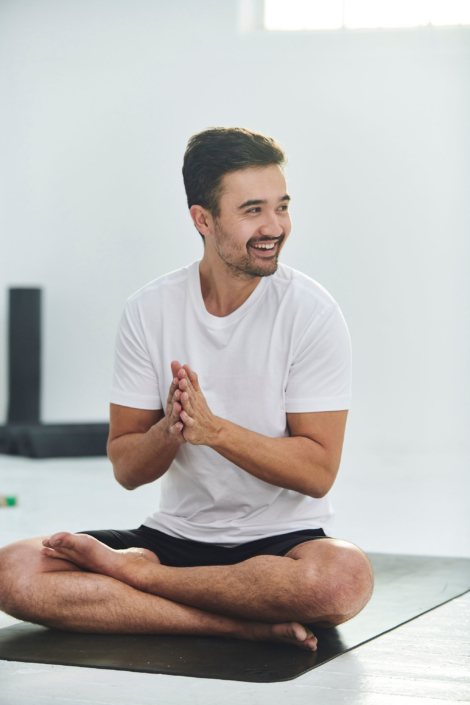Richie Bostock, or “The Breath Guy“, is a leading figure and evangelist for Breathwork, the next revolution in health and wellness. He is a Breathwork coach, author and speaker and it is his mission to spread the life changing possibilities of Breathwork to the world.
Having worn many hats, from a corporate management consultant to digital entrepreneur, Breathwork came into Richie’s life almost by accident when his father was diagnosed with Multiple Sclerosis (MS). When researching ways to help his father, he came to discover the Wim Hof Method, a self healing technique involving breathing techniques and cold exposure. After experiencing the incredible effects of this method in a week long training in Poland, he became obsessed with discovering what was possible just by breathing.
Richie spent years traveling across five continents learning from many of the modern day masters of Breathwork and continuously witnessed the transformative effects of when people became aware of their breathing and started to use it as a tool to create physical, mental and emotional benefits for themselves. This free medicine is available to everyone and it’s Richie mission to remind the world how to breathe with purpose.
Richie offers workshops, classes, one to one sessions and breathwork for business. Check out www.thebreathguy.com for more information.
You are a Breathwork Coach — what does this mean?
It means I get to teach people how to breathe for a living — it’s a real job!
What are the benefits of breathwork?
The way you breathe affects just about every system and function in your body such as your cardiovascular system, endocrine system, digestive system, nervous system, immune system and lymphatic system. If your breathing changes, whether consciously or unconsciously, then all these systems will change accordingly. It is the state of these systems that largely dictate our physical, mental and emotional health and wellbeing. Therefore, understanding and using the breath purposefully is a major skill that can help you to reduce stress and anxiety, increase energy levels, rebalance hormones, improve sleep and digestion, heal emotional trauma, alleviate chronic pain and improve cardiovascular health – just to name a few!
Is it similar to meditation?
If the goal of meditation is to go beyond the mind and experience our essential nature, which is often described as peace, bliss and total presence, then yes Breathwork can achieve the same thing. In fact, I call some of the routines I teach “Meditation on Rocket Fuel” because of the profound effect it has on calming the mind quickly and getting you to that place of no-thought. I have had countless people come up to me after a class saying that they have been trying meditation for years but have never gotten so deep into a state of presence than when doing the class.
The major difference is how you use the breath for each practice. In many styles of mediation they practice “watching the breath” as a way of going into meditative states. In Breathwork we will consciously change our breathing to do the same thing. I love meditation and I think that it is a very important practice. The process of sitting down and becoming the observer of your mind is such an important skill to cultivate. I actually combine the two in my personal practice. I do Breathwork and then go into a meditation. In this way, the Breathwork acts as a speed ramp into the meditation practice, helping to calm the mind quicker so that you get more bang for your buck while meditating.
Who is it good for?
If you have at least one lung then it means you can breathe, which means you have a tool that you can use to improve your physical and mental health and performance and emotional wellbeing.
What’s the best time of day to do breath work?
Anytime of the day is a good time for Breathwork. Whether you include it as a part of your morning routine, during the day while working away at your desk on a break, even in the evenings when you are winding down for bed. Breathwork can be incorporated into your everyday life so effortlessly.
What got you into breathwork?
Believe it or not I wasn’t always teaching people how to breathe for a living. Some time ago my Dad was diagnosed with Multiple Sclerosis, an autoimmune disease with no real widely accepted cure and a myriad of different and sometimes difficult drug treatments. Because there was no set treatment plan for MS, I was always on the lookout for different lifestyle changes and alternative treatments that could be useful for him. Eventually I came across a podcast by a man called Wim Hof, a Dutch man often referred to as “The Iceman”. In this podcast, he talked about a method he developed through his own experiences which is fantastic for everyone’s physical and mental health. What caught my attention is that he mentioned the method seemed to be really effective in helping people with autoimmune diseases, including MS. After researching his method more I learned that it had two main elements: cold exposure activities such as cold showers and ice baths and breathing techniques.
To cut a long story short, I travelled to Poland to attend a week long training to learn Wim’s technique and found the effects to be so profound, especially the breathing aspects. On return I taught my dad the technique. Fast forward a few years and my dad breathes and takes cold showers every morning and his MS has not progressed at all! After this I was obsessed with finding out what else people were doing using the breath, which has led me to travel across five continents learning from many modern breathing masters and witnessing the transformative effects of Breathwork.
How can people use breathwork at home during this stressful time? Can you give us any tips?
Most people take on average 22 – 29,000 breaths a day however most people are not aware that they are breathing poorly and fewer are aware about how poor breathing habits may be effecting their health and happiness. I would say that 80% of the general population breathe in a way that is anatomically sub-optimal leading to unnecessary physical, mental and emotional distress. The most common dysfunctional breathing pattern I see is a chest or clavicular breathing pattern which is very common in people who are chronically stressed. This pattern is obvious when a person inhales and their shoulders travel vertically significantly and their chest puffs out. Here you are using your neck, shoulders and upper chest muscles to expand your chest to breathe in air. These muscles are what are called “Secondary Breathing Muscles” and are designed to be used in short bursts when we need to breathe quickly (e.g. catching our breath after sprinting). They are not designed to be used 24/7 and will fatigue and can cause neck, shoulder and back pain.
On top of that, this style of breathing is neurologically linked to sending the body into a stress response by activating your Sympathetic Nervous System (SNS), so even if you have no reason to be stressed, if you breath in this way you would cause your body to go into a stress response – doesn’t sound so smart does it?
There are four basics elements to how you should breathe day-to-day at rest.. To summarise, they are:
* Breathe low — down into the belly first, feeling your lower ribs and abdomen expand.
* Breathe slow — between 9 — 12 breaths per minute.
* Breathe through the nose — that’s what it’s there for!
* Let go of your exhale — don’t blow out your exhale, just relax and let the air escape naturally.
Are there different types of breathwork? Is it like yoga, an ongoing practise or can you learn the techniques relatively quickly?
If you define Breathwork as anytime you intentionally become aware of your breath and use it to improve your physical and mental health and performance and emotional wellbeing. That means that the scope of techniques that I cover in my workshops is very broad. After all, the way we breathe is central to just about every part of life. To simplify things, let me share with you how I categorise all the different types of Breathwork techniques:
1. Everyday Breathwork
Quick techniques you can use throughout the day to quickly change your state
e.g. Decrease stress, anxiety, and nervousness, Create more energy, Help to sleep
2. Corrective Breathwork
Techniques to correct your breathing mechanics to improve your day-to-day breathing
e.g. Learning to breathe diaphragmatically
3. Performance Breathwork
Techniques to help you perform better in a physically demanding activity
e.g. increase athletic performance, speed up recovery
4. Mind-Body Breathwork
Techniques and practices to further improve your physical, mental and emotional health & vitality.
e.g. Pranayama, Qi Gong, Buteyko Method, Wim Hof Method, Techniques for medical issues
5. Integrative Breathwork
Methods of Breathwork for therapeutic purposes, healing and spiritual experience and exploration.
e.g. Rebirthing, Holotropic Breathwork, Transformational Breathing, Biodynamic Breathwork
Want to give it a try?
A simple place to begin, start getting comfortable in breathing more slowly. While many people habitually breathe at a faster than natural rate, consciously slowing down your breathing for a few minutes has been scientifically shown to shift your body into your parasympathetic (also known as ‘rest and digest’) response, promoting functions such as digestion, helping you sleep better and to feel more calm.
You can try this yourself with a technique called ‘coherence breathing’ Research on this technique has shown how breathing at a rate of 5 breaths per minute can help you to balance your nervous system in just a matter of minutes.
* Inhale through your nose for six seconds.
* Exhale through your nose for six seconds.
* Repeat this cycle for at least 3 minutes, but there really is no limit as to how long you can go.
* If six seconds feels like a struggle, reduce it to five or four seconds and get comfortable breathing at that rate first. You can then gradually build it up to six seconds.








